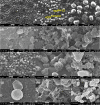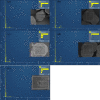Fabrication of polyamide-12/cement nanocomposite and its testing for different dyes removal from aqueous solution: characterization, adsorption, and regeneration studies
- PMID: 35907938
- PMCID: PMC9338974
- DOI: 10.1038/s41598-022-16977-8
Fabrication of polyamide-12/cement nanocomposite and its testing for different dyes removal from aqueous solution: characterization, adsorption, and regeneration studies
Abstract
Polyamide-12/Portland cement nanocomposite was prepared by using the exfoliated adsorption method. The fabricated nanocomposite was applied first time to remove Congo red (CR), brilliant green (BG), methylene blue (MB), and methyl red (MR) from the synthetic wastewater. The polymer nanocomposite was characterized by Fourier transform infrared spectroscopy, scanning electron microscopy, energy-dispersive X-ray spectroscopy, elemental mapping, Brunauer-Emmett-Teller surface area analysis, and X-ray diffraction. The adsorption was rapid and all the studied dyes were absorbed on the surface of the polymer nanocomposite in 90 min. The point of zero charge was found at pH 5 and the factors such as pH, time, and temperature were found to affect the adsorption efficiency. Freundlich isotherm and pseudo-second-order models well-fitted the adsorption isotherm and kinetics data, respectively. The calculated maximum adsorption capacity was 161.63, 148.54, 200.40, and 146.41 mg/g for CR, BG, MB, and MR, respectively. The mode of the adsorption process was endothermic, spontaneous, and physical involving electrostatic attraction. On an industrial scale, the high percentage of desorption and slow decrease in the percentage of adsorption after every five regeneration cycles confirm the potential, practicality, and durability of the nanocomposite as a promising and advanced adsorbent for decolorization of colored wastewater.
© 2022. The Author(s).
Conflict of interest statement
The authors declare no competing interests.
Figures













Similar articles
-
Methylene blue and Congo red dye elimination from synthetic wastewater using Albizia lebbeck seed pod powder: isotherm and kinetic and mechanistic studies.Int J Phytoremediation. 2024;26(14):2366-2377. doi: 10.1080/15226514.2024.2390190. Epub 2024 Aug 14. Int J Phytoremediation. 2024. PMID: 39140636
-
Development of banana pseudo stem cellulose fiber based magnetic nanocomposite as an adsorbent for dye removal.Int J Biol Macromol. 2024 Oct;278(Pt 2):134877. doi: 10.1016/j.ijbiomac.2024.134877. Epub 2024 Aug 19. Int J Biol Macromol. 2024. PMID: 39163967
-
In situ co-precipitation preparation of a superparamagnetic graphene oxide/Fe3O4 nanocomposite as an adsorbent for wastewater purification: synthesis, characterization, kinetics, and isotherm studies.Environ Sci Pollut Res Int. 2018 Jun;25(18):17310-17320. doi: 10.1007/s11356-018-1872-y. Epub 2018 Apr 13. Environ Sci Pollut Res Int. 2018. PMID: 29654454
-
Removal of methylene blue dye from aqueous solution using an efficient chitosan-pectin bio-adsorbent: kinetics and isotherm studies.Environ Monit Assess. 2023 Jan 27;195(2):339. doi: 10.1007/s10661-022-10900-4. Environ Monit Assess. 2023. PMID: 36705863
-
Synthesis of EDTA-functionalized graphene oxide-chitosan nanocomposite for simultaneous removal of inorganic and organic pollutants from complex wastewater.Chemosphere. 2022 Jan;287(Pt 4):132385. doi: 10.1016/j.chemosphere.2021.132385. Epub 2021 Sep 28. Chemosphere. 2022. PMID: 34597635
Cited by
-
Structure properties and industrial applications of anion exchange resins for the removal of electroactive nitrate ions from contaminated water.RSC Adv. 2024 Oct 23;14(45):33629-33648. doi: 10.1039/d4ra03871a. eCollection 2024 Oct 17. RSC Adv. 2024. PMID: 39444944 Free PMC article. Review.
-
Removal of methylene blue (MB) dye from water and wastewater using acid-activated chicken bone in a batch adsorption process.Sci Rep. 2025 Jul 2;15(1):23098. doi: 10.1038/s41598-025-08341-3. Sci Rep. 2025. PMID: 40596633 Free PMC article.
-
The effective treatment of dye-containing simulated wastewater by using the cement kiln dust as an industrial waste adsorbent.Sci Rep. 2024 Jun 25;14(1):14589. doi: 10.1038/s41598-024-64191-5. Sci Rep. 2024. PMID: 38918519 Free PMC article.
-
Fabrication of Anthocyanidin-Encapsulated Polyvinyl Alcohol Nanofibrous Membrane for Smart Packaging.Nanomaterials (Basel). 2024 Oct 24;14(21):1701. doi: 10.3390/nano14211701. Nanomaterials (Basel). 2024. PMID: 39513781 Free PMC article.
-
Application of carbon from pomegranate husk for the removal of ibuprofen, cadmium and methylene blue from water.Heliyon. 2023 Sep 19;9(9):e20268. doi: 10.1016/j.heliyon.2023.e20268. eCollection 2023 Sep. Heliyon. 2023. PMID: 37810158 Free PMC article.
References
-
- Baig U, Uddin MK, Gondal MA. Removal of hazardous azo dye from water using synthetic nano adsorbent: Facile synthesis, characterization, adsorption, regeneration and design of experiments. Colloids Surf. A Physicochem. Eng. Asp. 2020;584:124031. doi: 10.1016/j.colsurfa.2019.124031. - DOI
-
- Uddin MK, Mashkoor F, Al-Arifi I, Nasar A. Simple one-step synthesis process of novel MoS2@bentonite magnetic nanocomposite for efficient adsorption of crystal violet from aqueous solution. Mater. Res. Bull. 2021 doi: 10.1016/j.materresbull.2021.111279. - DOI
-
- Uddin MK, Bushra R. Synthesis and characterization of composite cation-exchange material and its application in removing toxic pollutants. Enhancing Cleanup of Environ. Pollut. 2017 doi: 10.1007/978-3-319-55423-5_9. - DOI
-
- Khan MA, Uddin MK, Bushra R, Ahmad A, Nabi SA. Synthesis and characterization of polyaniline Zr(IV) molybdophosphate for the adsorption of phenol from aqueous solution. React. Kinet. Mech. Catal. 2014;113:499–517. doi: 10.1007/s11144-014-0751-x. - DOI
-
- Uddin MK, Baig U. Synthesis of Co3O4 nanoparticles and their performance towards methyl orange dye removal: Characterisation, adsorption and response surface methodology. J. Clean. Prod. 2019;211:1141–1153. doi: 10.1016/j.jclepro.2018.11.232. - DOI
Publication types
MeSH terms
Substances
LinkOut - more resources
Full Text Sources
Miscellaneous

